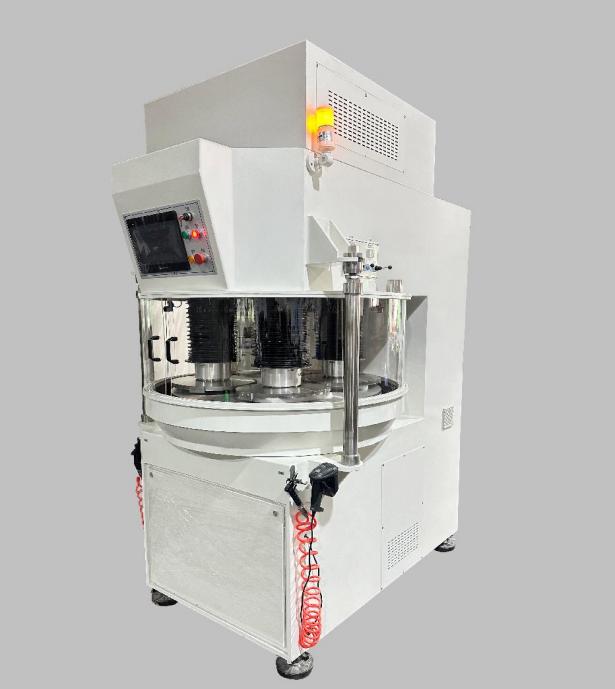How Semiconductor Materials and Optical Glass Improve Surface Effects Through CMP Polishing Machine
In high-end manufacturing fields such as semiconductor materials, optical glass, and precision ceramics, the flatness and finish of workpiece surfaces directly determine product performance. As equipment dedicated to high-precision processing, the
CMP Polishing Machine has precise control capabilities and stable processing effects. From micron-level size adjustment to nanometer-level surface optimization, it carves an extremely flat workpiece surface in a small area through the synergy of mechanical and chemical effects.
The core advantage of the CMP Polishing Machine comes from the composite processing mechanism of "mechanical grinding as the main method and chemical action as the auxiliary", which achieves a step-by-step improvement in surface precision through two-step synergy.In the mechanical grinding stage, the equipment drives the polishing plate to rotate at high speed via a motor. Abrasive particles attached to the surface of the polishing plate form continuous friction with the clamped workpiece surface. According to processing requirements, coarse-grained abrasives are selected for rough grinding to quickly remove protrusions such as defects and cutting marks on the workpiece surface;In the fine grinding stage, fine-grained abrasives are replaced to gradually eliminate micro-scratches left by previous processing, laying the foundation for subsequent fine polishing. During this process, the workpiece usually performs planetary motion in the bracket, forming a complex trajectory with the rotation of the polishing plate to ensure grinding uniformity.Chemical action is a key supplement to achieve an ultra-smooth surface. During polishing, the chemical liquid supply system continuously delivers polishing liquid containing specific components to the processing area through nozzles. Active substances such as acids and alkalis in it react mildly with the workpiece surface to dissolve the oxide layer and tiny debris generated by mechanical grinding.This alternating effect of "mechanical cutting - chemical dissolution" can not only avoid surface damage caused by pure mechanical grinding but also greatly improve processing efficiency, ultimately making the workpiece surface reach a mirror-level finish.
The high-precision performance of the CMP Polishing Machine relies on the precise cooperation of various core components, and it mainly consists of five functional modules to form a stable processing system:
- Polishing plate: As the core processing component, it is usually made of high-strength metal materials. Different consumables such as sandpaper and polishing cloth can be replaced according to the processed materials.
- Clamping device: It uses two mainstream methods, vacuum adsorption or mechanical fixture, to fix the workpiece, ensuring no displacement or shaking of the workpiece during processing. For thin and brittle materials such as sapphire glass, a flexible clamping mechanism is also equipped to avoid workpiece cracking due to excessive pressure.
- Power and pressure system: The motor provides adjustable speed power for the polishing plate, with a speed range usually covering 5-250rpm to adapt to the processing needs of different materials. The pressure system adopts the "cylinder + pressure sensor" or weight adjustment method.
- Chemical liquid supply system: Composed of a storage tank, a pump, and a nozzle, it can precisely control the flow rate of the polishing liquid to ensure the processing area is always in the optimal chemical environment. At the same time, the porous water outlet design prevents impurities from scratching the workpiece surface.
- Control system: With PLC as the core and a touch screen human-machine interface, it supports multi-program editing and storage.
The performance of the CMP Polishing Machine is mainly evaluated by the following four key indicators:
- Surface flatness: Measures the deviation between the workpiece surface and the ideal plane, which is the core requirement for high-precision processing.
- Surface roughness: Reflects the degree of micro-undulation on the surface, usually expressed by Ra value. Through precise abrasive selection and process optimization, the CMP Polishing Machine can reduce the Ra value of the workpiece surface to below 0.08μm, and some precision models can even achieve an ultra-smooth surface close to the nanometer level.
- Processing stability: Long-term processing precision is guaranteed through designs such as a knife dressing mechanism and a pressure compensation system. For example, the equipment can adjust the flatness of the grinding plate to ±0.01mm, and with the precise liquid supply of the pump, the qualified rate of batch processing can reach more than 98.53%.
- Adaptability flexibility: Expressed as the processing size range and material compatibility. Mainstream equipment can process workpieces with a maximum size of 1000mm and a minimum processing thickness of only 0.3mm, and can adapt to various materials such as silicon wafers, sapphire, glass, and stainless steel.
The CMP Polishing Machine relies on the composite processing mechanism of "mechanical grinding as the main method and chemical action as the auxiliary" and the precise collaboration of five core components such as the polishing plate and clamping device. It can realize surface optimization from micron-level size adjustment to nanometer-level. It performs excellently in ensuring key indicators such as workpiece surface flatness and finish in high-end manufacturing fields such as semiconductor materials, and has good processing stability and adaptability flexibility.













